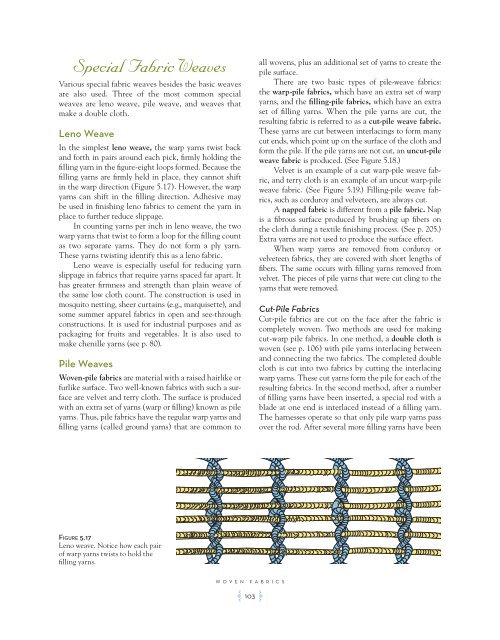You also want an ePaper? Increase the reach of your titles
YUMPU automatically turns print PDFs into web optimized ePapers that Google loves.
Special Fabric Weaves<br />
Various special fabric weaves besides the basic weaves<br />
are also used. Three of the most common special<br />
weaves are leno weave, pile weave, and weaves that<br />
make a double cloth.<br />
Leno Weave<br />
In the simplest leno weave, the warp yarns twist back<br />
and forth in pairs around each pick, firmly holding the<br />
filling yarn in the figure-eight loops formed. Because the<br />
filling yarns are firmly held in place, they cannot shift<br />
in the warp direction (Figure 5.17). However, the warp<br />
yarns can shift in the filling direction. Adhesive may<br />
be used in finishing leno fabrics to cement the yarn in<br />
place to further reduce slippage.<br />
In counting yarns per inch in leno weave, the two<br />
warp yarns that twist to form a loop for the filling count<br />
as two separate yarns. They do not form a ply yarn.<br />
These yarns twisting identify this as a leno fabric.<br />
Leno weave is especially useful for reducing yarn<br />
slippage in fabrics that require yarns spaced far apart. It<br />
has greater firmness and strength than plain weave of<br />
the same low cloth count. The construction is used in<br />
mosquito netting, sheer curtains (e.g., marquisette), and<br />
some summer apparel fabrics in open and see-through<br />
constructions. It is used for industrial purposes and as<br />
packaging for fruits and vegetables. It is also used to<br />
make chenille yarns (see p. 80).<br />
Pile Weaves<br />
<strong>Woven</strong>-pile fabrics are material with a raised hairlike or<br />
furlike surface. Two well-known fabrics with such a surface<br />
are velvet and terry cloth. The surface is produced<br />
with an extra set of yarns (warp or filling) known as pile<br />
yarns. Thus, pile fabrics have the regular warp yarns and<br />
filling yarns (called ground yarns) that are common to<br />
Figure 5.17<br />
Leno weave. Notice how each pair<br />
of warp yarns twists to hold the<br />
filling yarns.<br />
WOVEN FABRICS<br />
A 103 F<br />
all wovens, plus an additional set of yarns to create the<br />
pile surface.<br />
There are two basic types of pile-weave fabrics:<br />
the warp-pile fabrics, which have an extra set of warp<br />
yarns, and the filling-pile fabrics, which have an extra<br />
set of filling yarns. When the pile yarns are cut, the<br />
resulting fabric is referred to as a cut-pile weave fabric.<br />
These yarns are cut between interlacings to form many<br />
cut ends, which point up on the surface of the cloth and<br />
form the pile. If the pile yarns are not cut, an uncut-pile<br />
weave fabric is produced. (See Figure 5.18.)<br />
Velvet is an example of a cut warp-pile weave fabric,<br />
and terry cloth is an example of an uncut warp-pile<br />
weave fabric. (See Figure 5.19.) Filling-pile weave fabrics,<br />
such as corduroy and velveteen, are always cut.<br />
A napped fabric is different from a pile fabric. Nap<br />
is a fibrous surface produced by brushing up fibers on<br />
the cloth during a textile finishing process. (See p. 205.)<br />
Extra yarns are not used to produce the surface effect.<br />
When warp yarns are removed from corduroy or<br />
velveteen fabrics, they are covered with short lengths of<br />
fibers. The same occurs with filling yarns removed from<br />
velvet. The pieces of pile yarns that were cut cling to the<br />
yarns that were removed.<br />
Cut-Pile <strong>Fabrics</strong><br />
Cut-pile fabrics are cut on the face after the fabric is<br />
completely woven. Two methods are used for making<br />
cut-warp pile fabrics. In one method, a double cloth is<br />
woven (see p. 106) with pile yarns interlacing between<br />
and connecting the two fabrics. The completed double<br />
cloth is cut into two fabrics by cutting the interlacing<br />
warp yarns. These cut yarns form the pile for each of the<br />
resulting fabrics. In the second method, after a number<br />
of filling yarns have been inserted, a special rod with a<br />
blade at one end is interlaced instead of a filling yarn.<br />
The harnesses operate so that only pile warp yarns pass<br />
over the rod. After several more filling yarns have been













